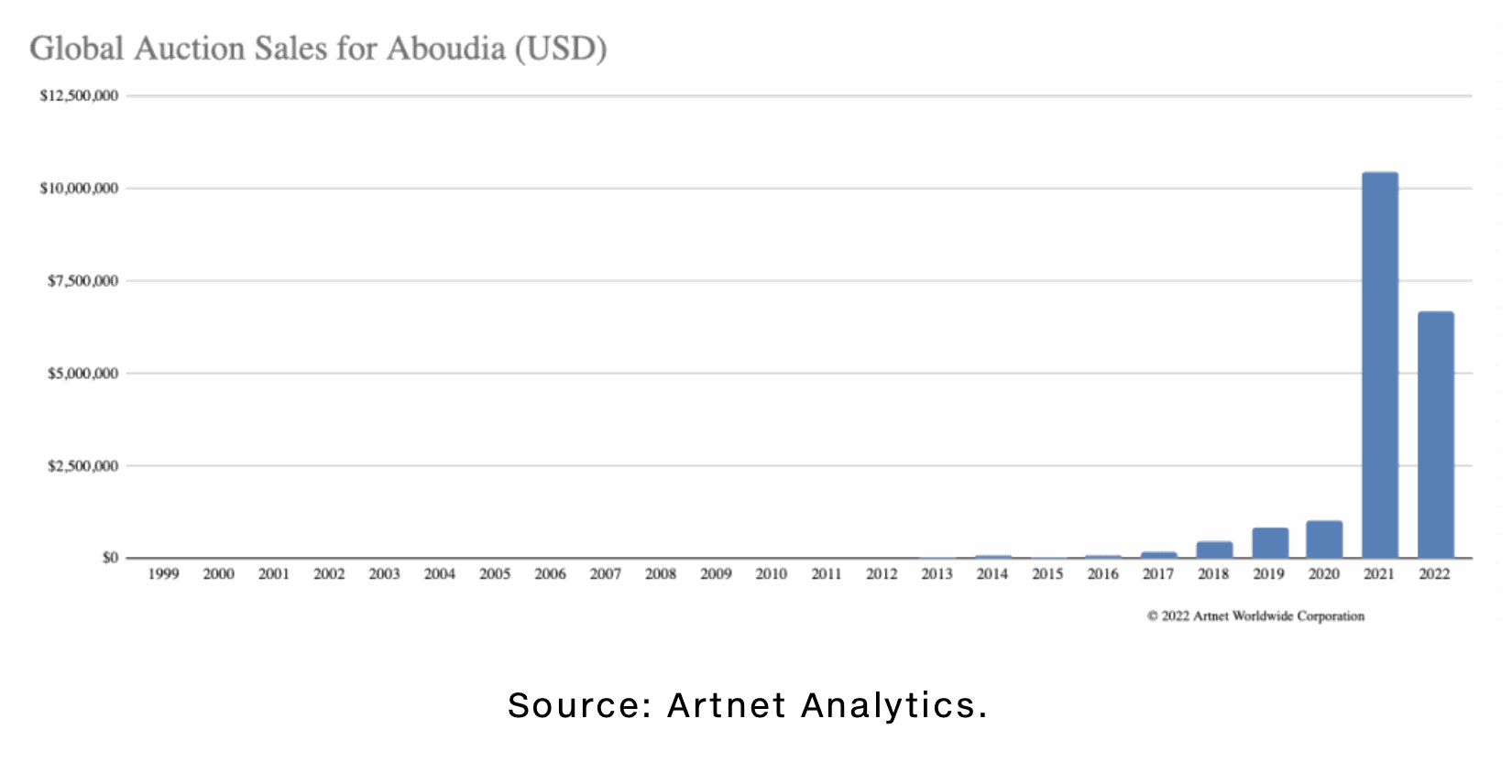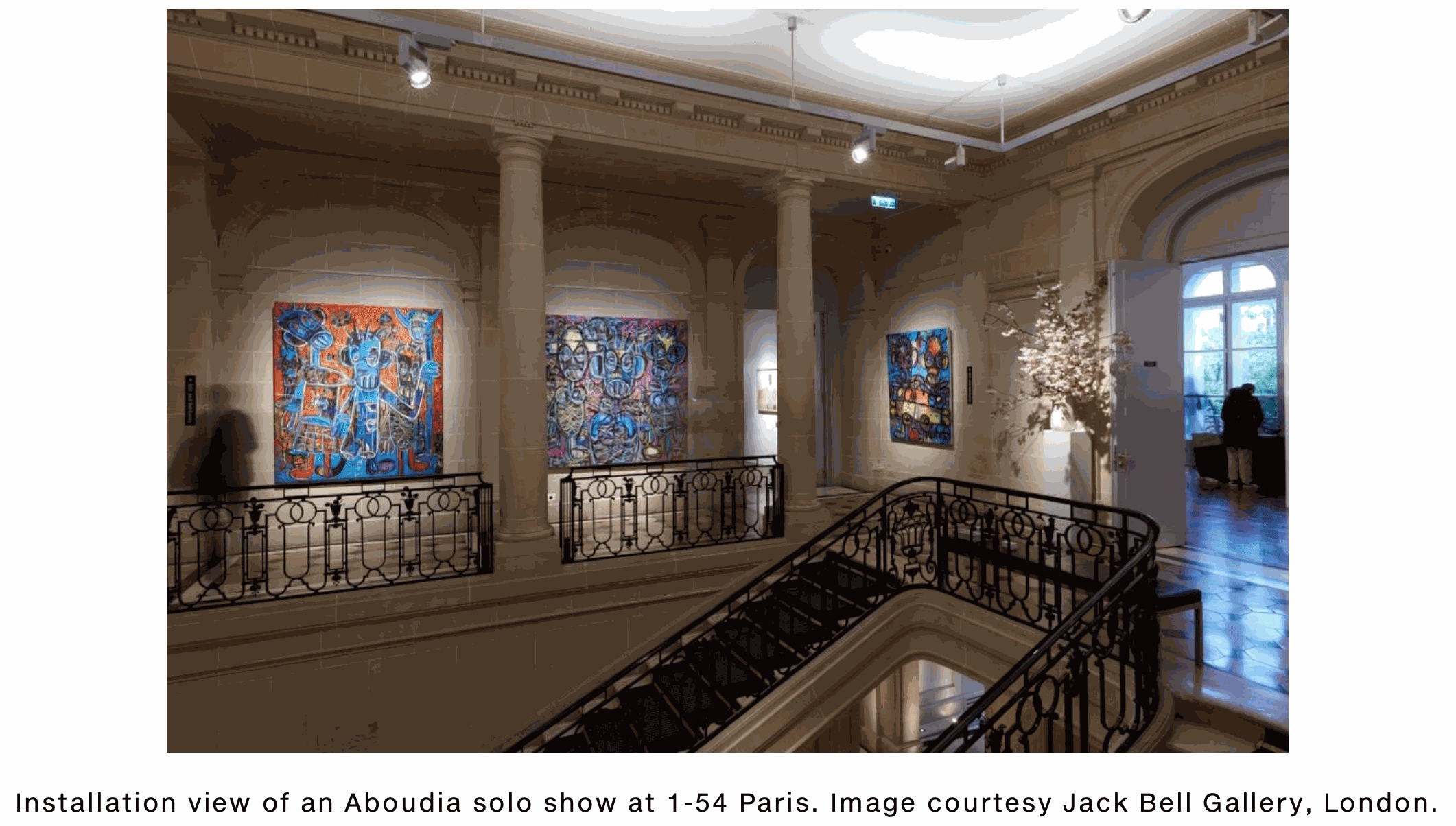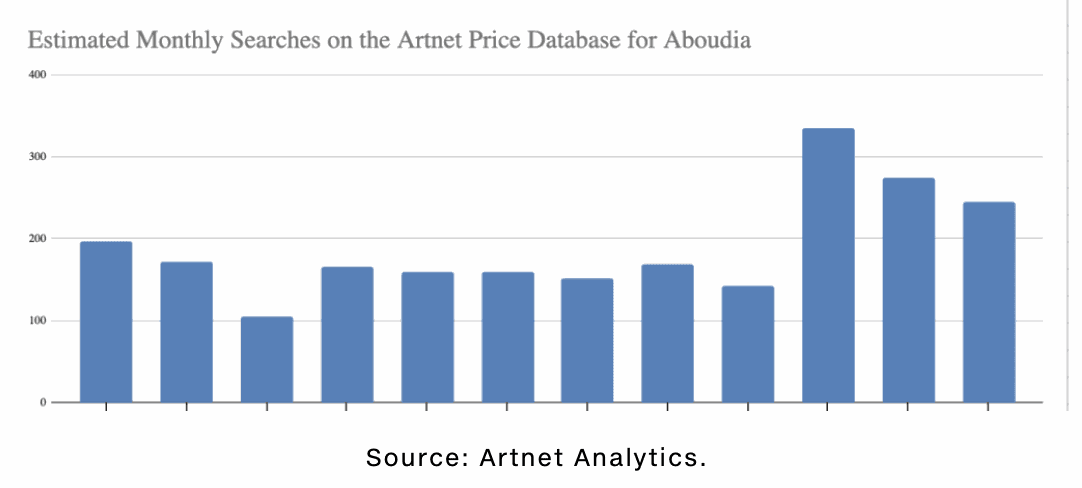Christie’s took something of a gamble last spring when it agreed to hold a sale of work by the Ivorian-American artist Abdoulaye Diarrassouba, better known as the mononymous Aboudia. To say it payed off handsomely is an understatement.
Auction houses don’t typically take direct consignments from artists, never mind an entire sale’s worth of work sent straight from the studio, paint barely dry. But the 21-lot online auction, held over the source of two weeks in February and March, exceeded all expectations when it pulled in just over $1 million.
In today’s overheated art market, that might not sound like a lot of money. But consider that the six top lots, which all carried low estimates of $10,000 to $12,000, soared to more than $100,000 each. All of the works are dated 2020 and have one single-line provenance: “From the artist.” Not since Damien Hirst’s notorious Beautiful Inside My Head Forever sale at Sotheby’s in 2009 has such a gutsy direct-to-auction sale been so successful.
The artist and an undisclosed representative approached Christie’s directly with the opportunity. Aboudia did not respond to a request for comment for this story, and his galleries have remained relatively mum on the sale. Christie’s contemporary specialist Michael Baptist knew it was unusual. “We talked about it internally at the time and what we saw was a unique opportunity,” he said. Some of the paintings and works on paper had estimates as low as $3,000; in almost all instances, they sold for prices over $10,000.

“It kind of kicked off the current secondary market activity that we’re seeing now,” Baptist said, in which paintings regularly exceed $100,000. “It engaged a lot of clients who had not seen or known much about Aboudia and had been collecting serious blue-chip work for a while.” Last year, Aboudia’s global auction sales totaled $10.5 million, and he is on track to beat that sum this year, with $6.7 million in sales to date. Three of his works sold this week at Phillips Hong Kong, each for at least twice its high estimate.
So who is Aboudia? And how did a millennial artist who was largely unknown just over a decade ago skyrocket to the top of the auction food chain? Even amid the current market fervor for work by African ultra-contemporary artists, who have amassed nearly $65 million at auction since 2019, the response to Aboudia’s work has been intense.
Behind the Rise
The artist’s dizzying paintings stopped New York dealer Ethan Cohen in his tracks when he spotted them at a London art fair around 2011. By that time, the artist had already been showing with Cécile Fakhoury, who has galleries in Abidjan and Paris, and London-based Jack Bell. The going rate for his works during this early period, according to Fakhoury, was between €1,000 and €12,000.
“I sent him a him a note saying, ‘Aboudia, I love your work I’d love to talk to you,’” Cohen told Artnet News. He brought the work to Basel, and then to Singapore and Hong Kong. That was before the market had become as international as it is now. “People thought I was crazy and asked, ‘Why would you bring African art to Asia?'”
The gamble paid off. “We sold out,” Cohen said. “It opened the door to Chinese, Indonesian, Japanese, and Filipino clients.” Cohen has shown Aboudia’s work at Volta Basel every year since, including at last month’s fair.
Jack Bell, who gave the artist his first show in 2011, said his audience has grown in tandem with the broader market for African contemporary art, boosted by events like the 1-54 African Art Fair. “Aboudia’s collector base has evolved to become very strong and international with a truly global audience,” Bell said.

The artist’s life and work are inextricably intertwined. His layered paintings—with varying amounts of oil stick, collage, spray paint, and tagging—reflect both the vibrant culture of street art in Abidjan, where the artist was born, and the political unrest that surrounded him, particularly following the country’s disputed presidential election in 2010.
The paintings reflect so-called “Nouchi” culture, a reference to the street kids he captures alone or in groups. “I feel close to [the children in my paintings] because when I decided to get involved in art, my family was against it and I left my home and lived alone,” the artist said in one interview. These figures often face off with armed soldiers, skulls, and semi-abstract depictions of children with vacant eyes or expressions of horror.
“The scenes Aboudia paints are rooted in his own experience, that of community and solidarity,” Fakhoury said.
Aboudia earned a degree in 2003 from the Technological Centre of Applied Arts in Bingerville. As violence in the region escalated, he reportedly took refuge in a basement studio and created work that was both a response to, and documentation of, the strife that surrounded him. (The artist now splits his time between Brooklyn and Abidjan.)
Not surprisingly, Aboudia’s raw, graffiti-style imagery has consistently evoked comparisons to 1980s art star Jean-Michel Basquiat. Though he adamantly denies the influence, and even ever having seen Basquiat’s work when he was starting out—he cites his only source of inspiration as the graffiti artists of his hometown—the comparison persists.
In Cohen’s view, the two drew from the same well: Basquiat, who also worked in oil stick, employed a lot of West African imagery in his work.
Who Wants In
In addition to the artist’s three main galleries—Fakhoury, Bell, and Cohen—Aboudia has earned the support of a number of powerful tastemakers. Charles Saatchi, an early collector, gave the artist a considerable spotlight in his two “Pangea” shows, which spotlighted new art from Africa and Latin America in 2014 and 2015.
Collector Jean Pigozzi, too, owns a few works by Aboudia. “Kind of reminds a bit of Basquiat,” Pigozzi said. “But he has his own very strong style.” Sources say Christie’s owner Francois Pinault also has several paintings, but may have sold a few amid the artist’s market ascent. Musician and actor Kano is a fan.
Experts say collectors gravitate toward medium and large canvases with figures, faces, chalk-like pastel, and collaged elements. On the secondary market, there is considerable demand for the earlier works from around 2011 that Aboudia created during the Ivorian crisis.
Nevertheless, Cohen clarified, “it all sells. He is the biggest seller I have ever encountered... bigger than Ai Weiwei.” (Cohen was the first to show Ai in the United States.) He estimates that there are roughly 450 Aboudia collectors worldwide.

All of this activity has some onlookers worried about a glut of supply. Even Baptist admitted to some uncertainty after the 2021 sale. “It’s like, okay, we just put 20 on the market—are the prices going to level out? And they continued to go up, and then we thought, okay, they’re making close to $200,000, they probably can’t make more than that—and then they’re selling for $300,000.”
A whopping 111 works were offered at auction last year, far more than many of his peers. All but one found a buyer. “People see a lot of his work now at auction and think, ‘Oh my god he’s over-productive,'” Cohen said, “but this is 10 years of work.”
His boosters say that volume is part of the appeal. “Collectors want to see that he’s been working for ten years and actually has variety in his practice,” Baptist said. “The market doesn’t suffer the same control that an artist only making ten pieces a year has to go through when reselling.”

Aboudia’s current record of $498,000 was set this past March at a Christie’s online sale, for Haut les mains (Hands up) (2020). Twenty-five works have sold above $200,000 each; roughly 75 have sold for more than $100,000. These figures, according to Jack Bell, are in line with the artist’s current primary-market prices, which range from $100,000 to $200,000.
“There’s been a surge of interest in Aboudia’s work,” said Simon Tovey, head of Phillips’ 20th century and contemporary art day sale in London.
Can the streak continue? We’ll find out: two more works by the artist are on offer in London next week.


